Want to know how to deal blackjack like a pro? In this complete guide by a former blackjack dealer you will learn the art of dealing the cards. Ready?
Peter Nairn has an extensive background in casinos. From Dealer to Pit Manager, to Shift Manager, to General Manager, to training hundreds of casino staff, he’s done it all.
Here he’s going to explain what the major casinos expect from their blackjack dealers, as well as explain how you can apply that knowledge to your games at home.
If you’ve ever wanted to have a few friends over for a fun ‘blackjack at home’ night or even plan on doing it professionally, but don’t feel that you know enough about the game, then this article is for you.
Here's what you'll learn:
Let’s get started!
Author's note
The article comes with all the information you need to know to run a game professionally, including how to shuffle, how to lay out the cards, what is Insurance and how do you deal that part of the game and so on, but I haven’t included the finer details of procedure and know-how that can take months of practice to learn.
During our many casino openings, we discovered that teaching people to deal blackjack works best if we teach the pitch game first.
It is then a simple transition to learning how to use the shoe.
We started our dealers off on a single deck.
When your hands aren’t used to handling the cards like a dealer, a single deck is plenty to... deal with.
Once they were comfortable with the single deck, we would introduce the double deck.
And then it’s a simple matter to introduce the shoe.
Learning to Deal the Pitch Game
The cards are held in the Dealer’s hand and are pitched to the players face down.
One or two decks are used in hand-held games.
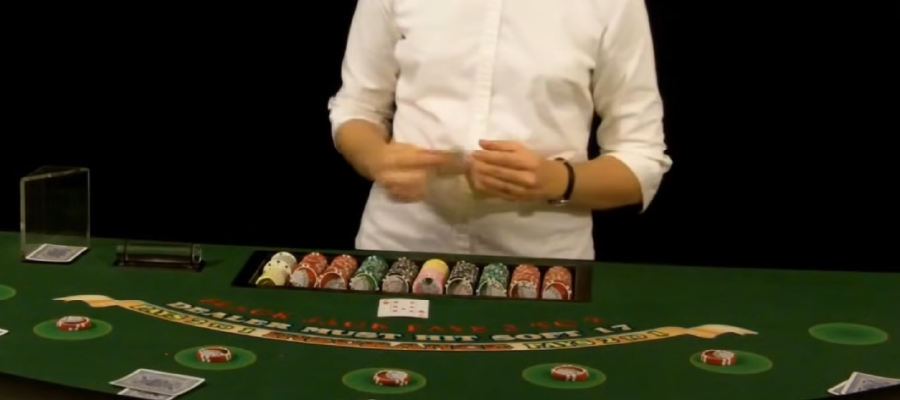
Note that the deck is held about waist-high and angled up at 45 degrees or so.
This is so the players cannot see the top card in case it is marked.
Can you see the deck in this picture?
No you can’t, and there’s a reason for that.
The deck is held in this position in the hand – note that the front of the deck is held across the front of the Dealer’s index finger, so the front of the top card cannot be seen by the players – again, in case it is marked.
In this image, you can see how you should hold the deck when dealing blackjack:
Pro tip: Don’t deal like in Poker on a Blackjack game
Here's how a poker dealer holds the cards:
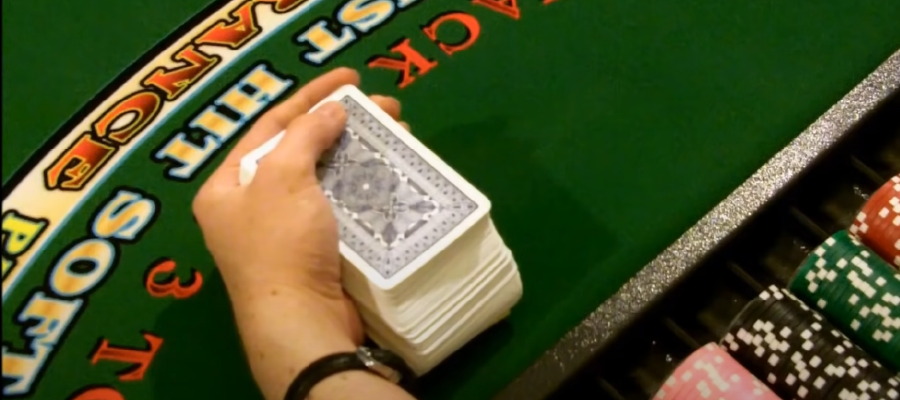
Holding the deck in blackjack is entirely different to how a poker Dealer holds the deck.
As a comparison, here’s how a poker Dealer holds the cards.
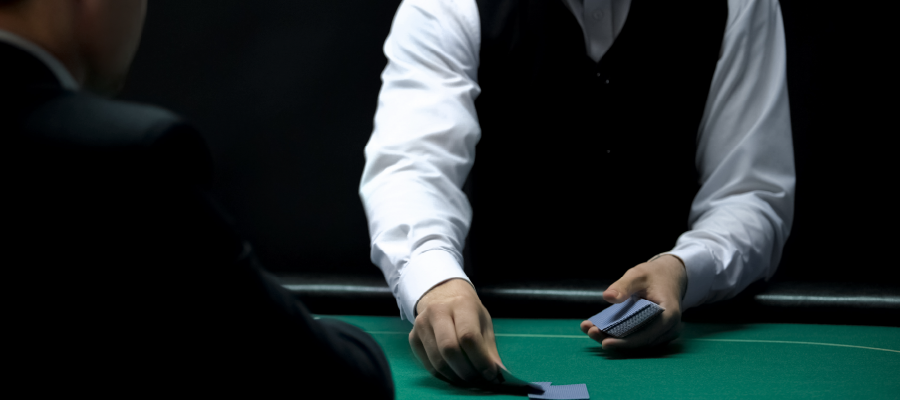
You can see the right-hand delivery is very similar, but the left-hand is very different.
Blackjack dealers are expected to be able to deal both from the hand and out of a shoe.
Most blackjack games are dealt face up from a shoe, a box where the cards are kept, and typically, a shoe game will be played with six decks of cards, and the players don’t touch the cards at all.
Blackjack shoes come in a variety of finishes.
This is a typical 6-deck blackjack shoe.
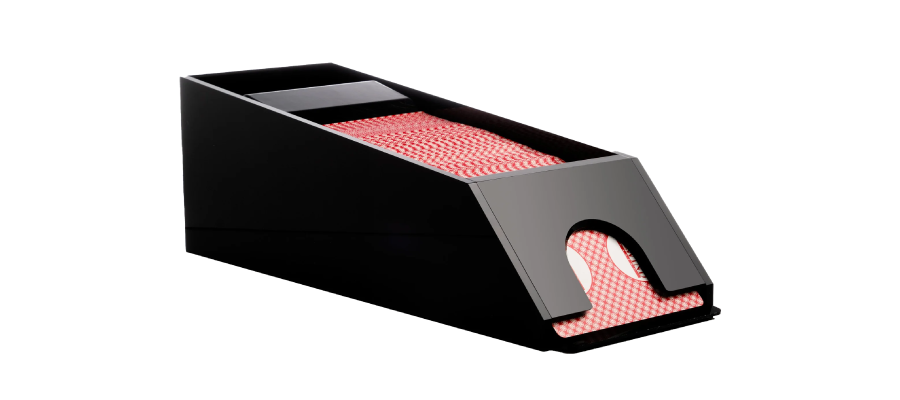
In the casino, the shoe is usually chained to the table.
Before you can start dealing blackjack, you need to be familiar with the basics.
I have written several guides in the Academy to help you familiarize yourself with the rules, but here’s a quick refresher:
Object of The Game
The player must get closer to 21 than the dealer, without going over 21. If the player is dealt an Ace and a 10-value card with their first two cards, that is called ‘blackjack’.
The game rules
- All cards are valued at their face value, and Jack, Queen, and King are worth 10.
- An Ace can be valued as a 1 or an 11.
- A hand that includes an Ace is called ‘soft’ if the Ace counts as 11, and ‘hard’ if it counts as 1.
Please note
The rules I include here are from a specific casino where I was the Vice President of Gaming Operations. I chose those rules to reflect how we wanted to run our games in the particular market we were in.
In the casino, there are several ways of doing things right, and each casino makes its own Policies and Procedures, while ensuring that they meet the limitations of the Minimum Internal Control Standards (the MICS).
The MICS are a set of rules generated by the National Indian Gaming Commission. All casinos on Tribal land have to be in compliance with them and with ‘the Compact’ (an agreement between the state and the Tribe as to how they will run their casino).
All traditional casinos are usually bound by their own rules and the rules of the state in which they operate.
Dealing Blackjack Single Deck
Here are the general rules:
- Single Deck Blackjack pays 6 to 5.
- On all other Blackjack games, Blackjack usually pays 3 to 2.
- Dealer stands on a Hard 17 and hits a Soft 17.
- Players may double down on 9, 10, and 11 only.
- Double downs are allowed after splits.
- Pairs can be split up to three times to make a total of four hands.
- Split Aces receive only one card on each Ace.
- Customers are allowed to handle their cards but may only use one hand to do so.
- Customers must be seated to play unless approved by a Floorperson or above.
Single Deck Automated Shuffle
A shuffle is done:
- When the cut card appears during play and that hand is subsequently completed.
- Whenever the deck has been dropped, or otherwise mishandled.
- Whenever instructed to do so by the Floorperson.
The Dealer will place the old deck into the shuffler and bring out the new deck and offer the Customer the cut.
Cutting the Deck
- Upon completion of the shuffle, the Customer is offered the cards to be cut.
- The Customer cuts the cards by placing the cut card in the stack at least 10 cards or more from the top or the bottom.
- The Dealer will place the cut card in the middle of the deck (1/2 of the deck will be dealt).
- “Burn” the first card from the deck by placing it face-down into the discard rack.
Single Deck Manual Shuffle
The shuffle will be:
- Cut the deck in half
- RIFFLE, STRIP, RIFFLE, STRIP, RIFFLE, BOX, TURN, RIFFLE
- Present cards to the Customer for the cut.
- The Customer will place the cut card in at least ten (10) cards from the top or bottom of the decks.
Double Deck Manual Shuffle
The shuffle will be:
- Cut the deck in half.
- Cut deck in half again, forming four (4) equal piles. The piles will be at the corners of an imaginary rectangle 12” x 6” (30 cms x 15 cms), in the Dealer’s work area.
- Cards will be shuffled from diagonal stacks using a riffle, strip, riffle, strip, riffle, box, riffle.
- Stack in the top middle of the rectangle and repeat with the other two (2) piles.
- Place the second stack of shuffled cards on top of the first.
- Break in half, turn the right pile 180 degrees and then riffle both piles together.
- Place the shuffled cards on a cut card.
- Present cards to the Customer for the cut, offering a second cut card to the Customer.
- The Customer will place the cut card in at least ten (10) cards from the top or bottom of the decks.
Shuffling in a casino is very strictly controlled.
There is no ‘wiggle room’, it must be done exactly the same way every time, no exceptions.
The deck is laid flat on the table in the middle of the Dealer’s work area.

Cut the deck in half and place the halves next to each other.
Ideally, there are 26 cards in each pile. A couple of cards one way or the other is fine.
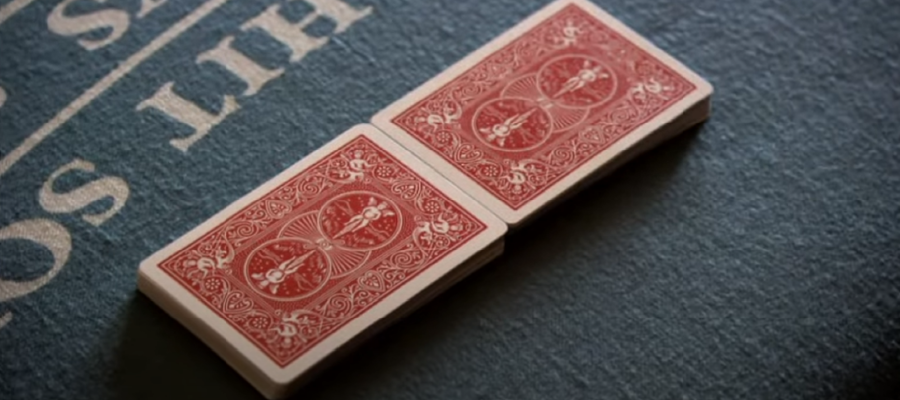
Lay your hands flat across the top of the decks like this.
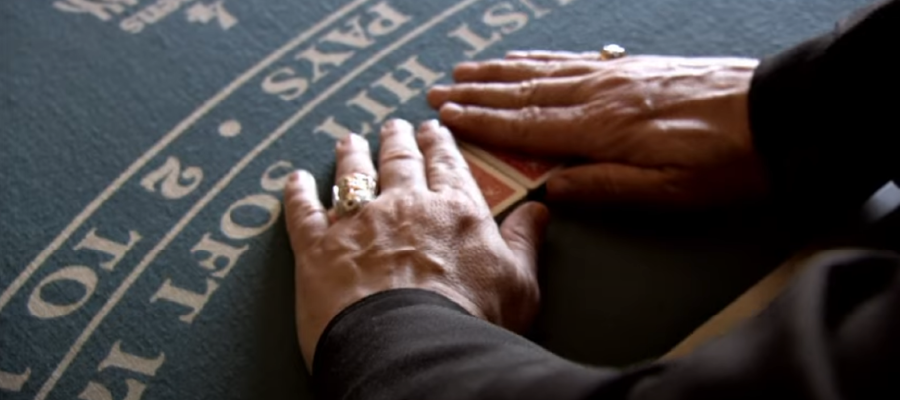
Angle the two halves towards each other.
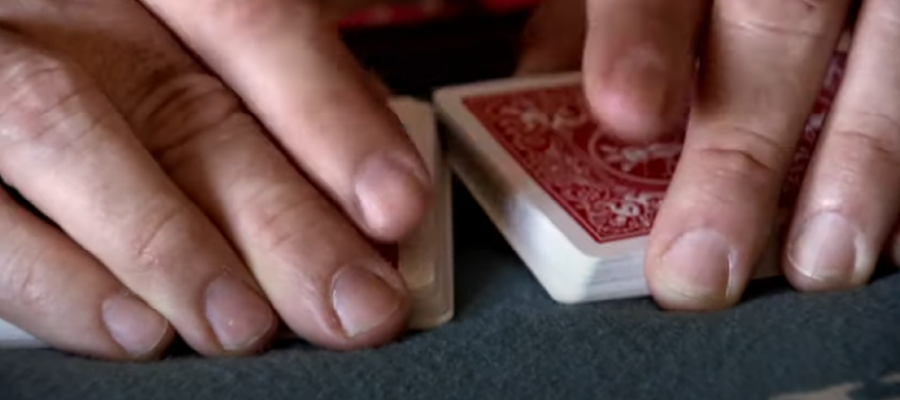
If you put the two halves parallel with each other, the cards will not interlace as you shuffle them.

Lift each side and riffle them together.
Here’s how you riffle them together.
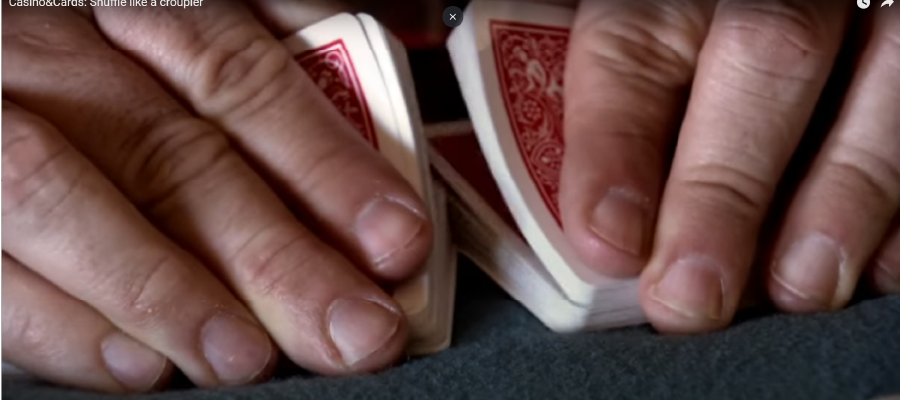
It’s like you are riffling the pages of a book.
Here are a couple of views of what it looks like from different angles.
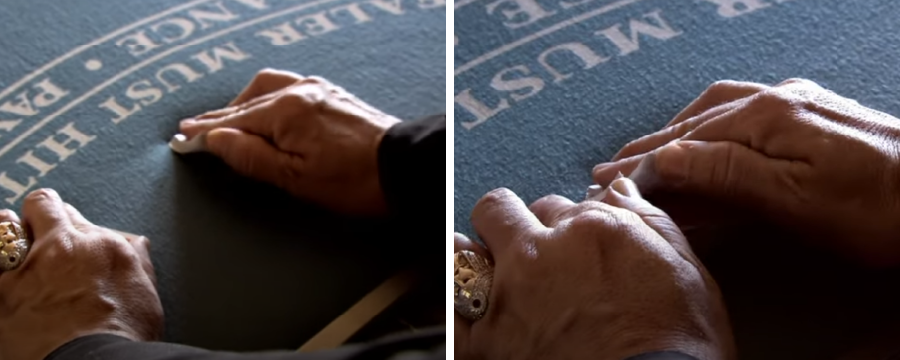
Of course, when doing a real shuffle, your hands are never apart like this.

This height is a little exaggerated to demonstrate the motion; ideally you bend the cards as little as possible, while still getting a good mix of cards.
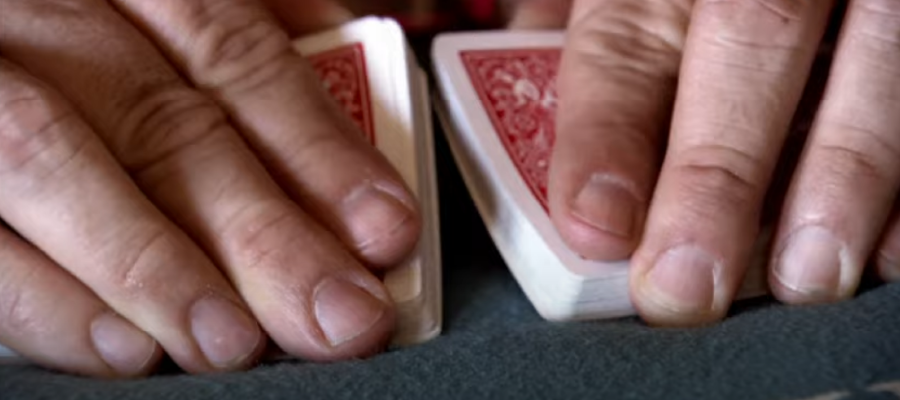
A good mix is that, at a minimum, there are no clumps of more than 5 cards.
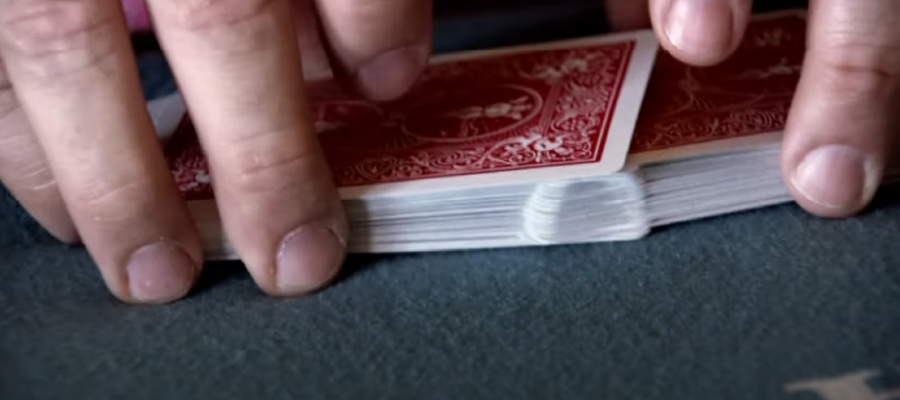
Then push the two interlaced halves together.
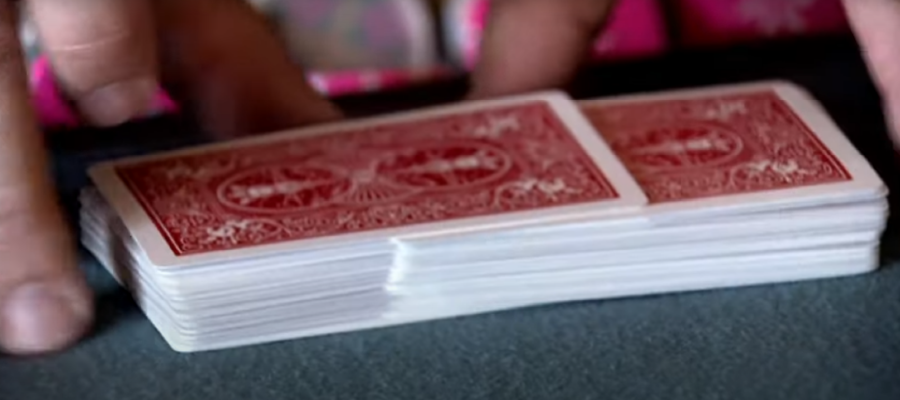
As you can see, this is a very good mix of cards, with no clumps at all.
The Strip
1. Start with the deck squared up in both hands.
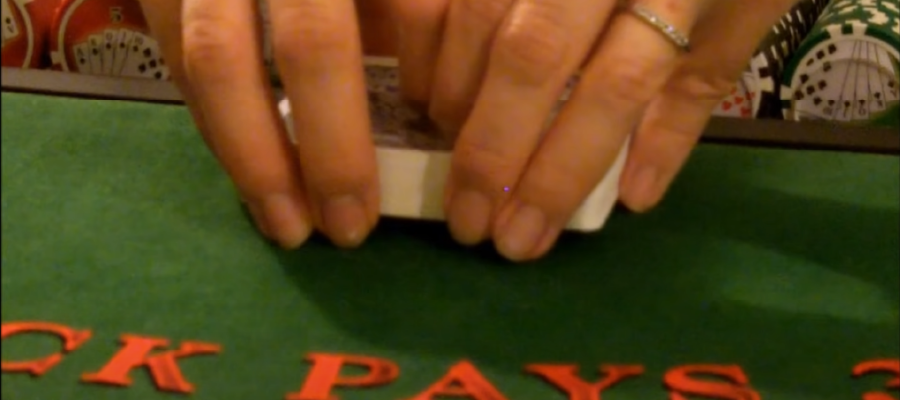
2. With the right hand, strip about 10 - 15 cards off the top of the deck, and place flat onto the layout.
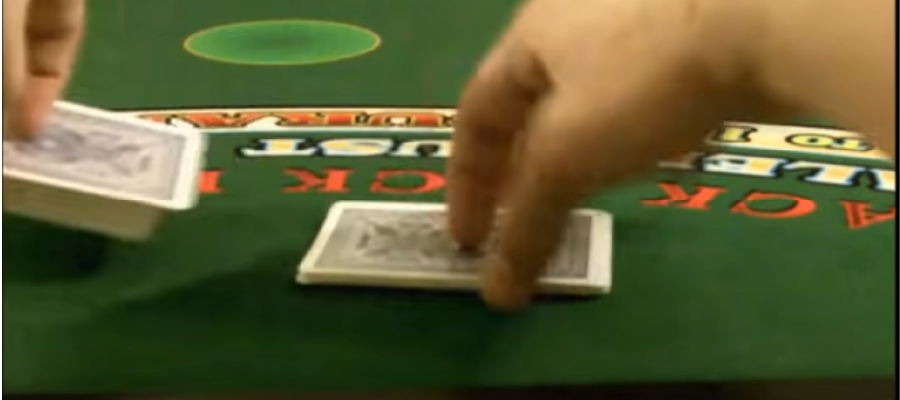
3. Continue to strip the deck, approximately 3 to 5 times.
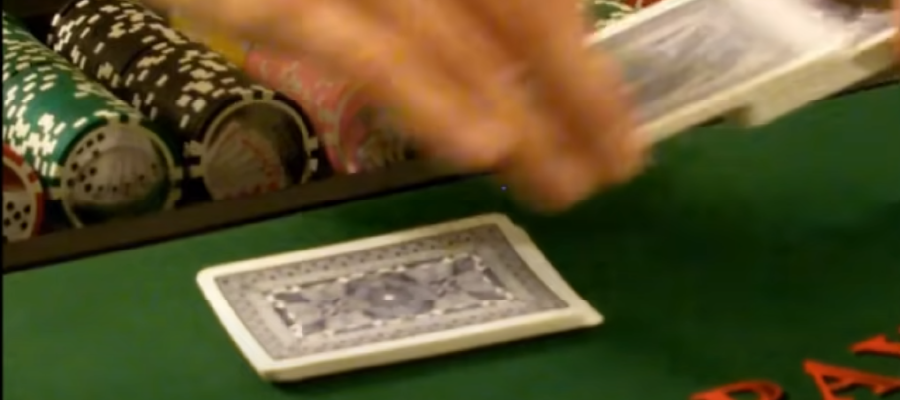
4. Until you have gone through the entire deck.

The Box
Start with the deck squared up in your hands.
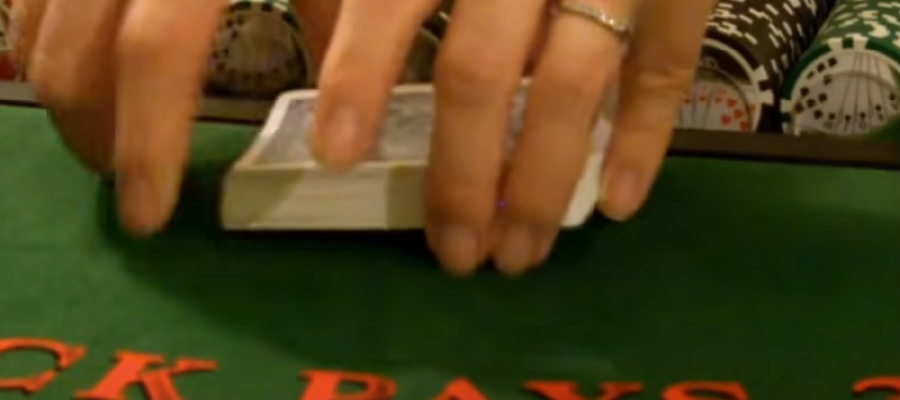
Remove a third of the deck from the bottom.

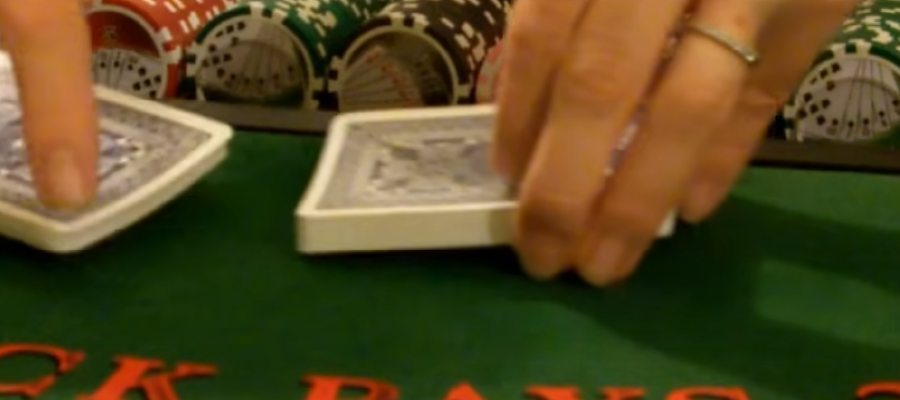
Turn it 180 degrees.
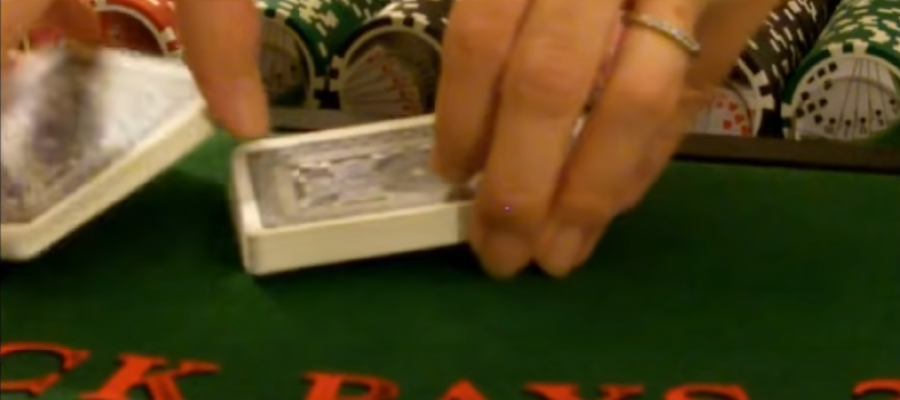
And then place it on the top of the remaining cards.

The Turn
Split the deck in half and turn the side under your right hand 180 degrees.
Complete another riffle.
The Cut
Offer the cards to the player to be cut with the deck parallel to the top of the table, and no more than 1/2 an inch off the layout.
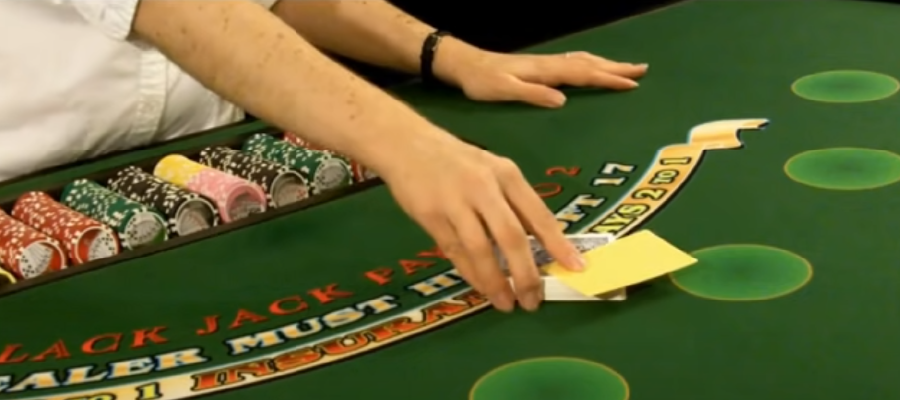
By keeping the deck low to the layout, you are protecting the bottom card.
Double Deck shuffle
- Cut the deck in half, place the two piles horizontally in front of you about 12 inches (30 cms) apart
- Take half from each pile, bringing the half towards you about six inches (15 cms), forming 4 equal piles.
- Cards will be shuffled from diagonal stacks using a riffle, strip, riffle, strip, riffle, box, riffle.
- Stack in the middle and repeat with the other two (2) piles.
- Place the second stack of shuffled cards on top of the first.
- Break in half, turn the right pile 180 degrees, and then riffle both piles together.
- Present cards to the Customer for the cut.
- The Customer will place the cut card at least ten (10) cards from the top or bottom of the decks.
6-Deck Shoe shuffle
Once the cut card comes out, complete the hand as usual.
Place the cards from the last hand in the discard rack and bring the shoe to the middle of the table.
- Remove the remaining cards slug from the shoe and place it near the discard rack.
- Take the top one-third of the slug and insert into the discarded cards 1/3 from the top
- Take the next one-third of the slug and insert it into the middle of the discarded cards
- Take the remaining one-third of the slug and insert it into the discarded cards 1/3 from the bottom
- Take the shoe and place it to the Dealer’s left
- Remove the cards from the discard rack and place them in the center of the table.
Begin the shuffle:
- Divide the cards into two even stacks called Stack L (to Dealer’s left) and Stack R (to Dealer’s right)
- Cut Stack R in half and place the bottom half on top
- Take half a deck from Stack L and half a deck from Stack R and place in one pile
- Riffle once; strip 3-5 times, place between Stack L and R.
- Center stack is now Stack M.
- Take approximately half a deck from Stack L and half a deck from Stack M.
- Riffle once, strip 3-5 times then place on Stack M.
- Take approximately half a deck from Stack R and half a deck from Stack M
- Riffle once, strip 3-5 times then place on Stack M
- Repeat above until all the cards have been shuffled
- Divide the shuffled cards into two stacks and place the cut card between the two stacks.
- Take approximately half a deck from Stack L and approximately half a deck from Stack R, place in a pile, strip 3-5 times, riffle once and place the cards in a laced position on top of the cut card.
- Take half a deck from Stack L and half a deck from Stack R and place in a pile.
- Strip 3-5 times, riffle once and, leaving the cards in a laced position, place them on top of the previous laced stack on the cut card.
- Repeat procedure until all cards have been shuffled.
- After all cards are shuffled, the Dealer asks for approval to proceed by saying “Shuffle Through”.
- After the Floorperson gives approval, the Dealer will complete the roll over and square the decks by pushing the laced cards together (note a cut card is covering the bottom card).
- Use the shoe to facilitate squaring the decks up; note that you can change the shape of the decks from a rectangle to a parallelogram, making the overall deck narrower so it fits into the shoe easier.
- The Dealer offers the deck to the Customer for the cut, making sure not to extend the cards past the Insurance line.
The ‘Shuffle Through’
Square up the decks using the side of the shoe.

Note how the Dealer is using the pinky of her left hand to keep the shoe in place, and the remaining fingers to support the cards, while her right hand is squaring up the cards.
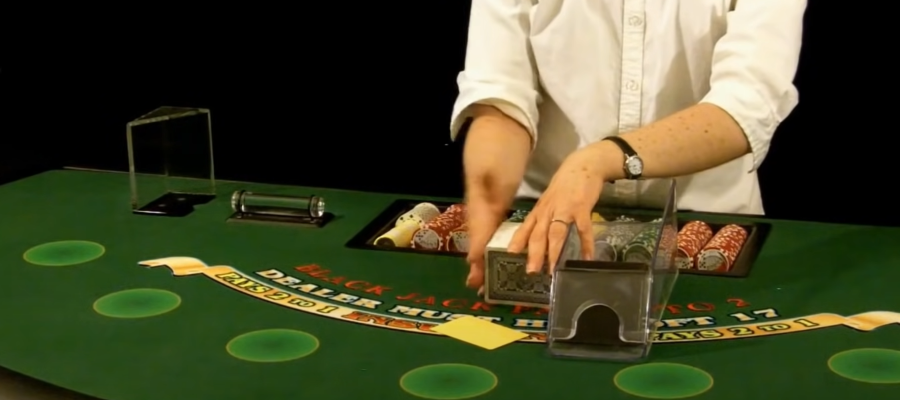
Offering the cards for the player cut.

Note how the cards do not go beyond the Insurance line.
When dealing out of the shoe, always try to keep one hand on the shoe, covering the aperture where the cards come out. This is a security measure to make it more difficult to see the next card out in the event the cards are marked.
Here are the steps required to open a game:
- The Floorperson will break the seals of each deck at the table.
- The Dealer will ensure that the proper number of decks used for the game are present.
- Both the Dealer and the Floorperson must be present at the game when the bankroll cover is unlocked and removed
- The Floorperson must verify all amounts, by denomination, indicated on the Table Inventory Slip (TIS) as the Dealer verifies the physical count in the game bankroll. In the presence of a Floorperson, the Dealer will remove the $25 denomination cheques and higher and verify them by running down a stack and matching them to the other stacks.
- The Dealer will verify all remaining cheques.
- If the TIS is correct, the Dealer and the Floorperson will sign it and drop it in the drop box.
- If an error is found, the mistake is logged on an Error Notification Slip (ENS) and signed by both the Dealer and the Floorperson and given to the Pit Manager. The Pit Manager will sign it and the drop box copy will be put in the drop box by the Dealer. The remaining 2 copies will be handed in to the Shift Manager at the end of the shift. Any discrepancy over $100 should be brought to the Shift Manager’s attention as soon as possible.
Procedures for closing a game
Here are the steps required to close a game:
- When the Floorperson notifies the Dealer of his/her game closing, the Dealer shall bring up the chip tray lid and place it on the layout.
- The Floorperson will complete the TIS as the Dealer verifies, by denomination, the physical count in the bankroll. In the presence of the Floorperson; the Dealer will verify the cheque count in the tray.
- The $25 denomination cheques and higher must be taken out and proved.
- The Dealer and the Floorperson will sign the TIS.
- The Dealer will drop the original (closer) copy into the drop box and place the duplicate (opener) in the tray, making sure that the opener does not obscure any of the high value cheques in the tray .
- The Floorperson will place the third copy with the Pit paperwork, which will be handed in to the Shift Manager at the end of shift.
- The lid is then placed on the game and locked by the Floorperson or higher.
- The Dealer will double-check the security of the tray lid and ensure that all dealing equipment (shoe, paddle, etc.) is secure prior to leaving the game.
Putting New Cards on a Game
- The Floorperson will break the seals of the new decks at the table;
- The Floorperson will remove the ancillary cards and jokers, and tear halfway into each card;
- The additional cards will be put back in their boxes;
- The Floorperson will remove the used decks;
- The Dealer will spread the new cards face-down in an arc inside the Insurance line;
- The Dealer will complete a wash with the cards face-down;
- The Dealer will riffle the cards once and place them into the shuffler.
When opening a double deck blackjack table, both decks will be spread before the wash begins; the first deck will be spread left to right, the second deck will be closer to the Dealer and spread right to left.
The wash will commence and both decks will be washed together.
The Wash
The wash is done face down, using both hands to mix the cards.

It’s a similar motion to the ‘wax on, wax off’ shown in the movie ‘The Karate Kid’.
Mix the cards thoroughly, completing 8 to 10 ‘wax on, wax off’ circles mixing the cards.
Then bring all the cards together into one rough pile.
The easiest way to pick them all up is to take one card and slide it under the pile, using it as a platform to support all the cards while you pick them up, and then put them on their side and work them together, facing towards you.
The players will make their bets using chips (or as the casino staff call them, cheques).
The higher value chips go on the bottom, with the lower value chips on top.
The Dealer is responsible for sorting them out into the various denominations before the cards are dealt.
Usually, the players will do this for you before they make the bet. If they don’t, it’s called ‘a barber pole’, and must be sorted out before you start to deal.
The rule is ‘just like pancakes, the big ones go on the bottom’.
Winning bets should be paid color for color if possible, with mixed color bets being broken down and each color paid separately.
Please Note
Players sometimes like to play two or three hands. If they want to play two hands, they must bet both hands at double the table minimum.
If they want to play three hands, all three hands must be at triple the table minimum.
On a $25 or greater minimum table, the player can play multiple hands at the table minimum, based on space availability. The Floorperson’s decision on playing multiple spots is final.
Here’s the correct delivery of cards:
- All cards will be pitched face-down to each Customer and the Customer is allowed to handle the cards.
- The cards will be pitched over the bet, so they land gently immediately behind the betting circle and in front of the player.
- Customers must use only one hand when handling their cards and they must always keep the cards over the layout.
- If a Customer is playing more than one hand, the cards of the second hand will be tucked to the Dealer’s right, under the Customer’s bet until the Customer has acted upon their first hand. When playing two hands, the Customer must act on the first hand before looking at the second hand. In the event the Dealer has an Ace up, the Customer may check both hands (one hand at a time).
- If the cut card appears in the middle of a hand, after the hand is completed, the cards will be shuffled.
- If the cut card is the first card of a new hand, no cards will be dealt and the deck should be shuffled immediately.
This is a double deck.
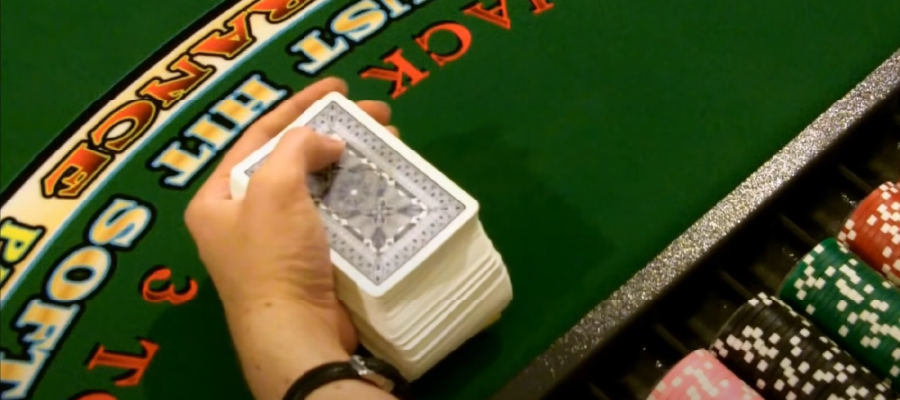
Note that the top card cannot be seen by the players because the deck is laid flat along the front finger of the hand.
The remainder is squeezed into the hand, cupped by the three other fingers.
There is a second cut card on the bottom to protect the bottom card.

To deliver the next card, the thumb moves into the center of the top card and slides it across to the right.
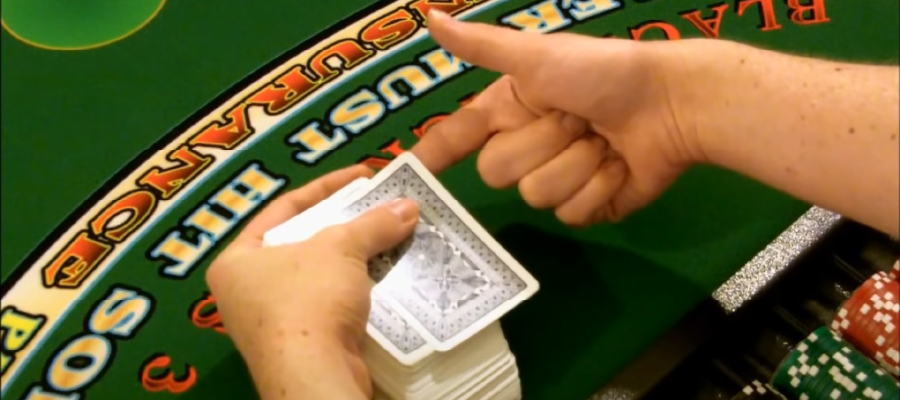
The card is held by the right index finger and thumb.
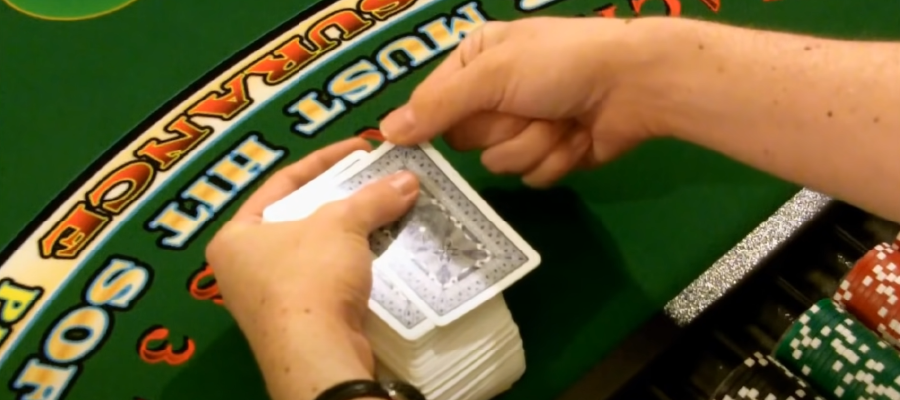
The card is delivered by the middle finger in a flicking motion, gently directing the card towards the player.
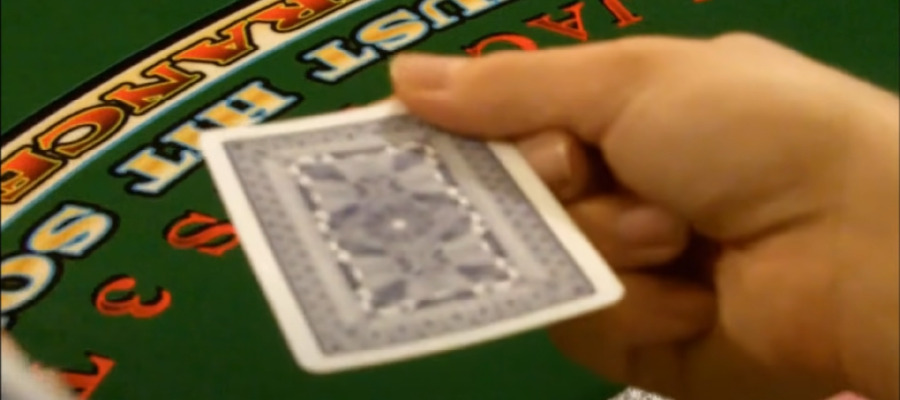
The card should land gently behind the bet, face down and in front of the player.
You can clearly see the position of the middle finger in this picture to the right
The card at the moment of release.
The hand after the release, with the card on it’s way.
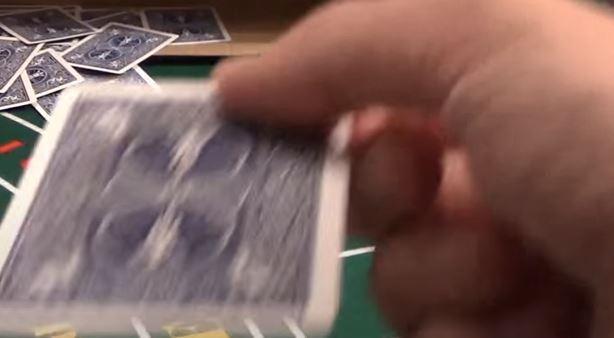
When learning to deal, try holding a small coin with the ring and pinky finger in this position to keep them in the correct position.

Burying the Hole Card
The Dealer’s up card is placed face up in the middle of the Dealer’s work area.
Approach the up card.
Note that the deck is flat and low to the table.
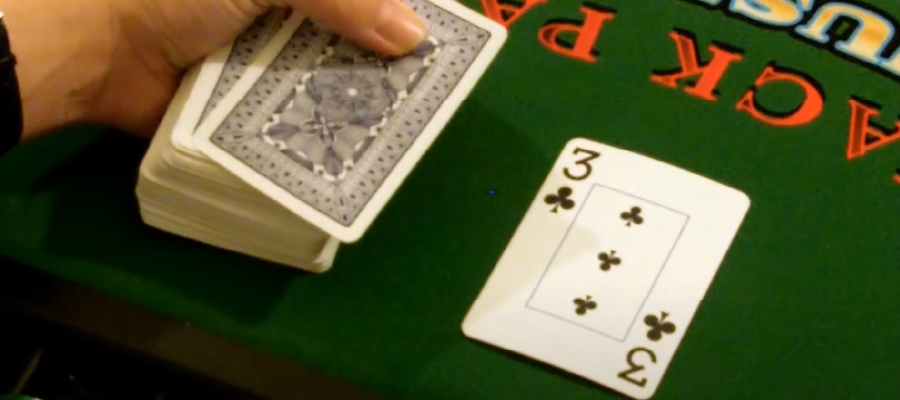
The top card is placed between the index and middle fingers of the right hand and immediately brought down to the surface of the table.
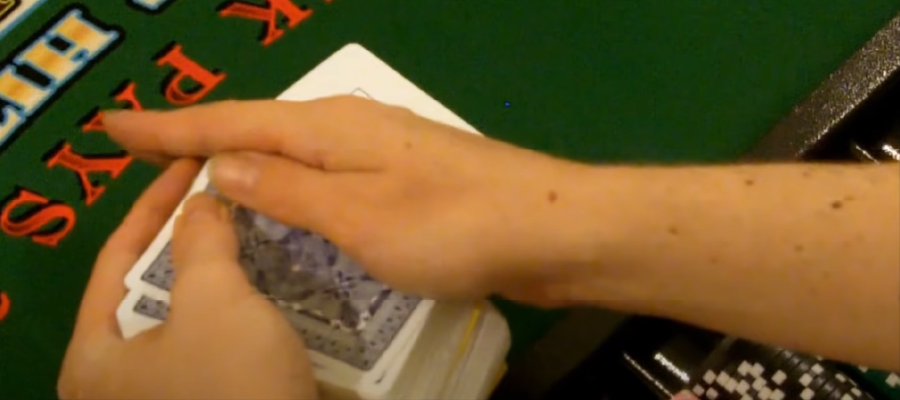
Some Dealers prefer to place the card between the middle and ring fingers.
Another view of how to hold the hole card prior to slipping it into place.
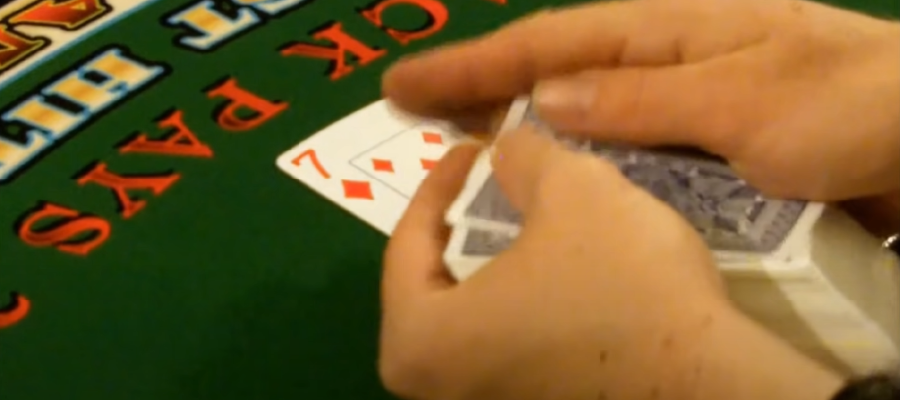
The reverse view of how to hold the card in the right hand. Youi can just see the left hand sliding the top card over into the right hand.
Moving it into position beside the up card.

Slide it in under the up card.
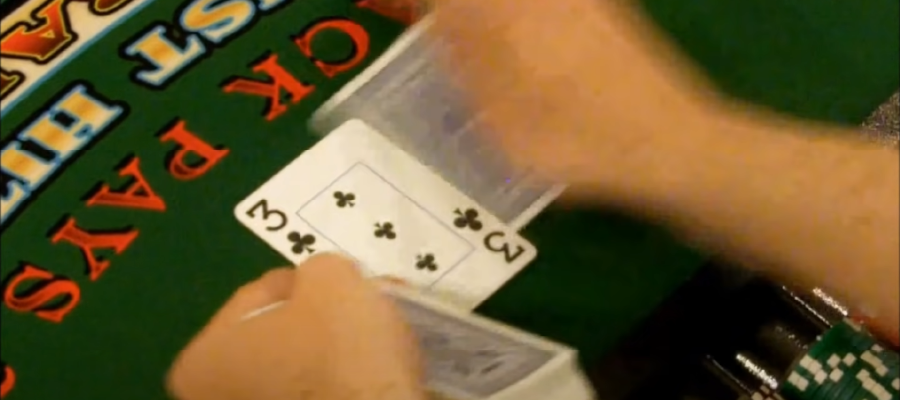
Note that the left hand is pressing down lightly on the left side of the up card to raise the right side of the card
This allows the hole card to slide into place more easily.
Then square it up so the hole card cannot be seen under the up card.
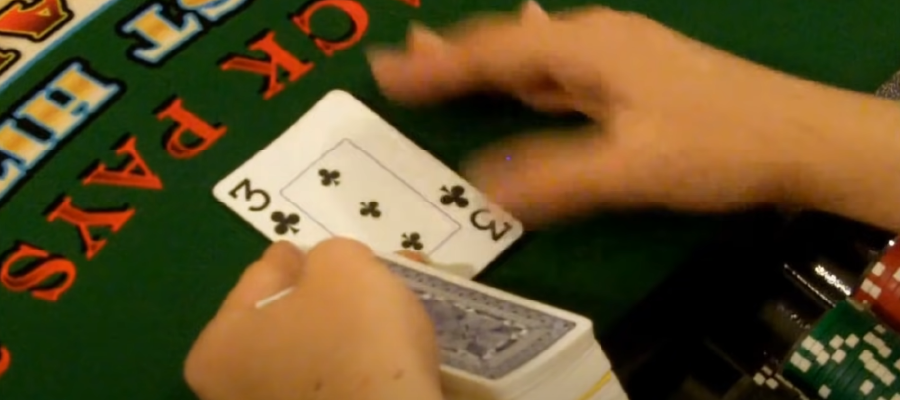
Where to Place the Hit Cards on a Handheld Game
The hit cards are placed on the layout, right in front of the players bet.
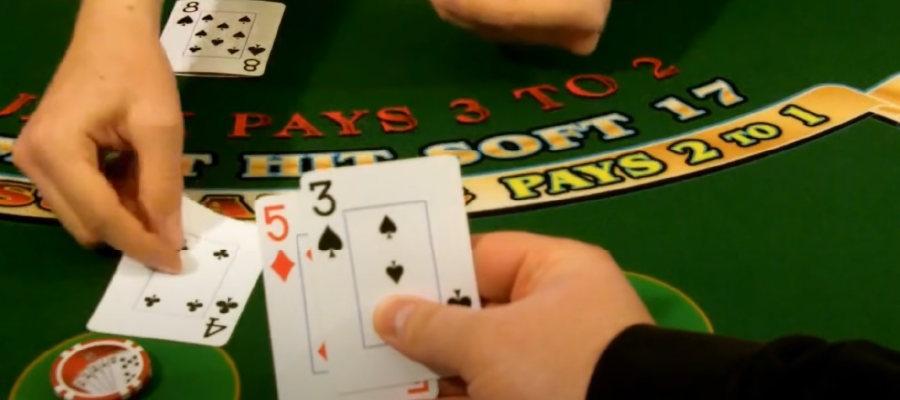
Subsequent cards are placed with the top right-hand corner of the card being placed in the middle of the previous card.
Learning How to Pitch Cards
Pitching cards is an acquired skill and just like riding a bike, it takes a little practice and once you get it, you’ll be surprised that it took you a while to learn how to do it.
The best way to learn is to start with a single deck of new cards.
Stand up at the kitchen table and pitch the cards onto the table. Don’t be too concerned about where they land because you’re just trying to get the technique down in the beginning.
Take a small coin, such as a US quarter, or a British 20p piece, or a 1€ coin, or a 50 Bani Romanian Leu.
Hold it with the ring and pinky fingers of your right hand as in the ‘after release’ photo above.
What this does is to ensure that your hand and fingers are in the right place when practicing pitching the cards.
At first the cards will go all over the place because your fingers don’t want to cooperate. This is normal, and everyone goes through the same issues. Just like I did, too.
Slowly, your pitch will be a little more consistent. Practice by trying to pitch them into a spaghetti pot or similar.
Sitting on the couch watching television with the pot between your feet is a terrific way to practice.
When you can go through the whole single deck three times in a row without missing any, you’re ready.
Dealing From the Shoe
With your left hand, slide the card out onto the table from the aperture in the shoe.
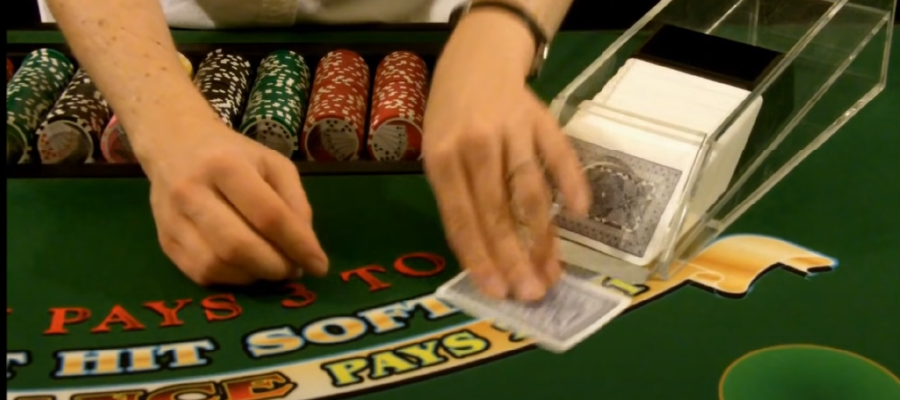
Slip your left thumb underneath the card and pick it up so that your right hand can take it from your hand easily.
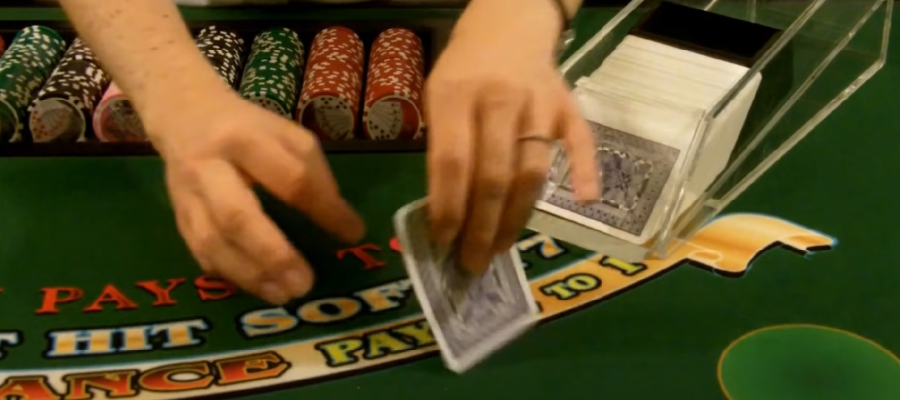
Take the card in your right hand between your index and thumb, and middle finger.
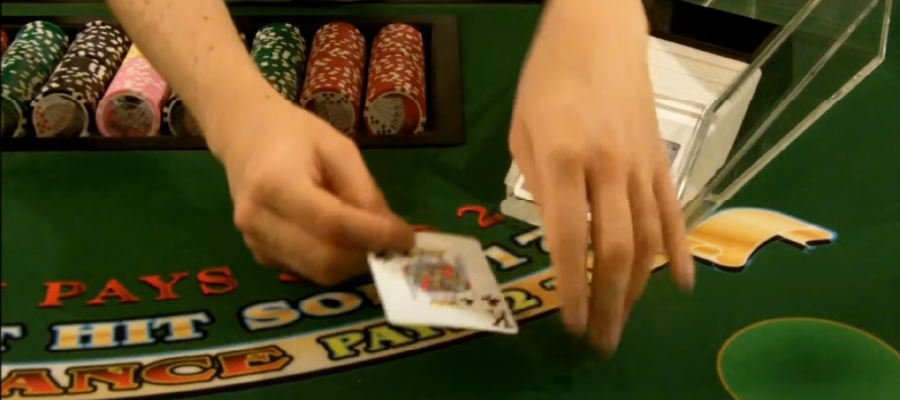
Gently place the card onto the layout in the correct position.
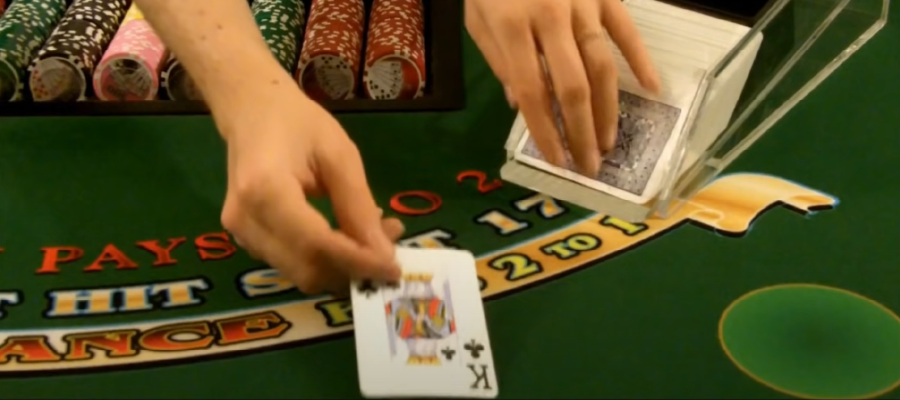
The card should not be bent at all as you put it down.
Dealing the Cards from the Shoe and Card Placement

Here the Dealer has dealt everyone’s first card.
I prefer to see the cards dealt parallel to the Insurance line, instead of all pointing towards the Dealer’s side of the table like in the picture.
Note that her up card is left face down until she gives herself her second (hole) card.
The players are all given their second card in order left to right around the layout.
All the players now have their second card.
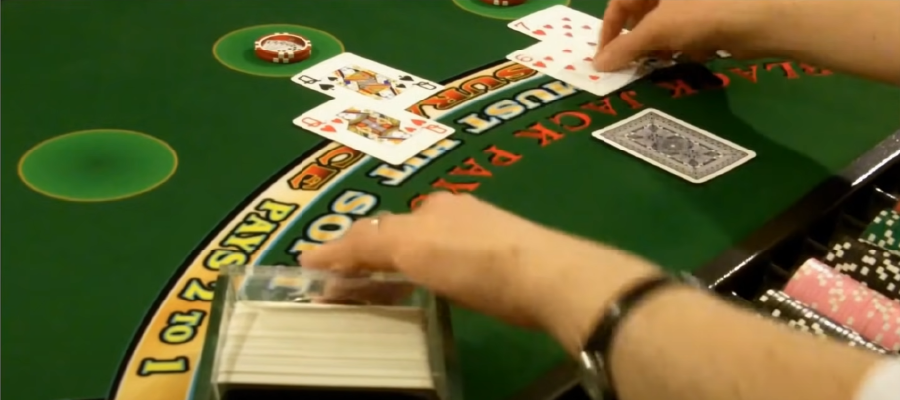
Note the Dealer’s up card is still face down.

Now the Dealer gives herself her hole card.
She draws the card out of the shoe and slides it across the table, next to her first card.
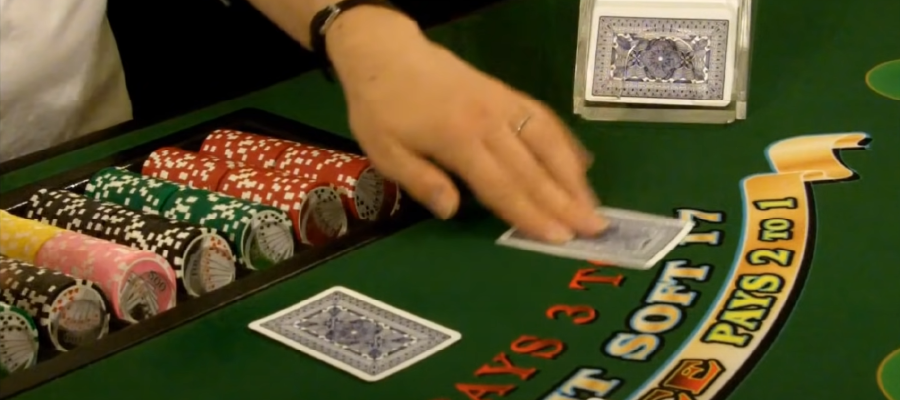
Her left hand brings the hole card from the shoe next to the first card, her up card.
Her right hand turns the first card over, exposing it to the players.
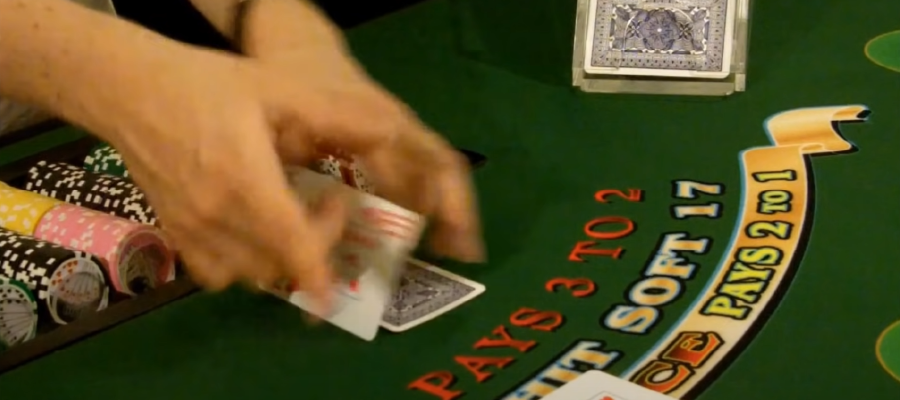
She then squares it on top of the hole card so that the none of the hole card can be seen by the players.
Note how the Dealer has laid the cards out in the picture below.
Imagine you’re the Floorperson on the other side of the pit.
It’s easy to see the value of the hand because you can see every pip on the cards – even though you can’t read the numbers because you’re too far away.
Here’s how you practice adding up many small cards.
Take a double deck and remove all the tens and faces.
Shuffle them and deal out several cards, like this first picture.
You are looking for patterns. The first and easiest one to use is to find cards that add up to 10.
In this hand, there are a couple of ways to see them.
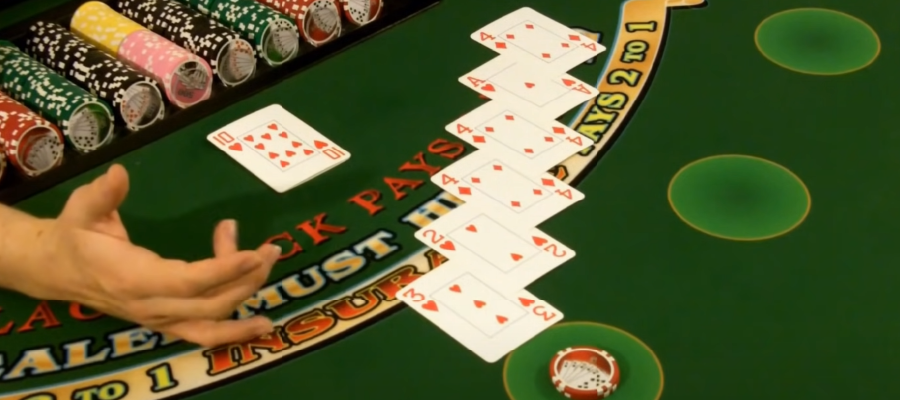
The first is the 2, 4, and 4, 2nd from the bottom. Then add the 3 at the very bottom and the 4 + 1 at the top, which adds up to 8. Then 10 + 8 = 18
Or you could take the bottom 3 and 2, plus the top 4 and 1, which gives you 5 + 5 = 10, and the two 4s in the middle makes 18.
You can also use the 2, 3, and 4 at the bottom. Anytime you have three consecutive cards like this, just multiply the middle one by 3. So 3 x 3 = 9
And 4 + 1 + 4 = 9. Then 9 + 9 = 18.
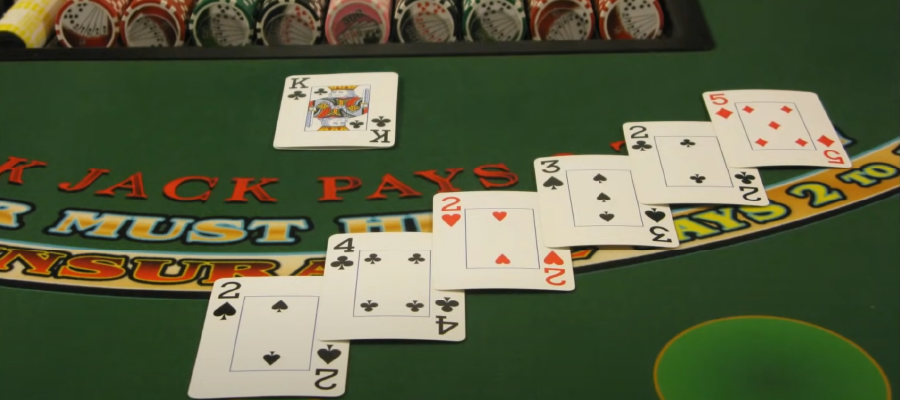
In this second picture, the 5 at the top right, then the 3 + 2 next to it gives you 10.
Then it’s 2 + 4 + 2 = 8, for a total of 18.
After all Customers have acted on their hands, expose the Dealer’s hole card by picking up the up card and flipping the hole card over.
The hole card is to the Dealer’s left, and the up card is to the right of it.
When required, hit the Dealer’s hand to the Dealer’s right of the exposed cards.
When hitting the Dealer’s hand:
- Each card must be visible.
- Some of the layout (from a quarter of an inch to half an inch or so) should show between each card.
- If necessary, reposition the cards so that they do not overlap.
- If the Dealer draws a card in error, do not try to fix the error and notify the Floorperson immediately.
Understanding Dealer's hand rules
Each casino has it’s own rules.
A couple of places to look for different rules are whether the casino hits or stands on a Soft 17 or if you can double down on any first two cards or only 9, 10, and 11.
These are typical rules that change the House Advantage.
Hitting a Soft 17 vs standing on it changes the HA in the casino’s favor by 0.22%. Allowing a double down on any two cards vs. only 9, 10, or 11 changes the HA in the player’s favor by 0.11%. Going from 6 decks to 2 decks increases the HA in the player’s favor by 0.16%
These numbers are rounded for easier understanding, but you get the picture.
While they don’t seem like much, in a game that usually holds about 0.75%, changing the rules by a few fractions of a percentage point can be a big deal.
Here are some of the things you need to consider mid-game:
The Peeker
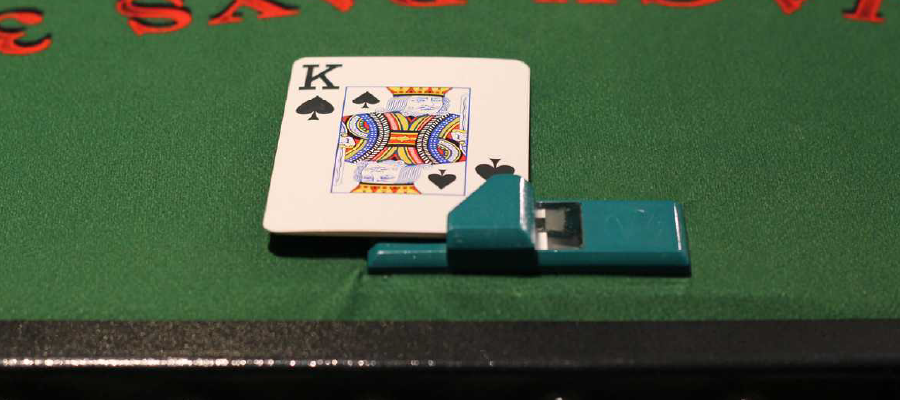
This is called a peeker.
It allows the Dealer to check her hole card for a blackjack with no possibility of anyone else seeing what she has.
In a home game, it’s highly unlikely that you will have a peeker to use, so push the up card forward with your fingers and use your thumb to lift the hole card and discretely check it.
Checking the hole card on a single or double deck game.
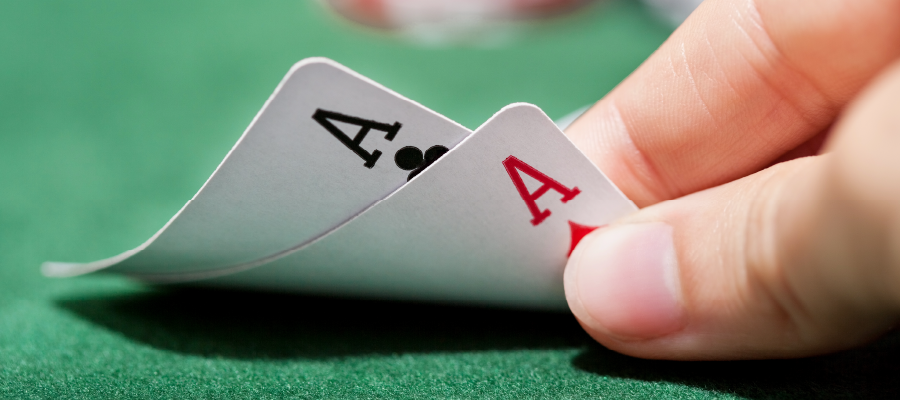
Use your left hand to screen the hole card with the deck in your hand.
Try to bend the cards as little as possible.
The cards here are quite bent to better illustrate the motion.
Checking the hole card on a shoe game
Use your free hand to screen the hole card on a shoe game.
Blackjacks
When a Customer receives a Blackjack, the Customer will turn over their Blackjack by placing their cards in front of their bet face up. If the Dealer shows a 2 through 9, the blackjack will be paid immediately. The Customer’s cards will then be placed into the discard rack.
If more than one Customer has a Blackjack, they will be paid in order from the Dealer’s right to the Dealer’s left.
If the Dealer’s up card is a ten-value card
- Do not offer Insurance.
- Check the hole card.
- If the hole card is anything but an Ace, the Dealer will immediately pay the Blackjack, place the Customer’s cards in the discard rack and then continue with the hitting sequence.
- If the Dealer and the Customer each have Blackjack, it’s a push.
- If the hole card is an Ace, announce ‘blackjack’, flip the hole card and take the losing wagers.
- If a Customer has placed a bet to double down or split, that money is not taken.
If the Dealer’s up card is an Ace
- Offer Insurance. Do not offer ‘even money’ on a 6 to 5 blackjack game.
- Check the hole card.
- If the Dealer does NOT have Blackjack, collect all losing Insurance wagers, pay all remaining Blackjacks, and then continue with the hitting sequence.
- If the Dealer HAS Blackjack, then collect the losing original wager and use it to pay the Insurance wager one Customer at a time going around the table right to left.
Insurance
- When the Dealer’s up card is an ace, call out “INSURANCE” in a loud and clear voice. At the same time, run your right hand from left to right pointing at the Insurance line.
After giving the Customers a reasonable amount of time to make an Insurance Bet, the Dealer MUST call out in a loud and clear voice, “Insurance closed,” while making a right to left motion along the Insurance line.
- The easiest way to think of the Insurance bet is that it is a bet that the Dealer has a blackjack.
- All Insurance wagers will be placed after the second card is dealt to each Customer and prior to any additional cards being dealt to them.
- The Insurance Bet is placed on the layout in the designated space on the line marked “2 to 1 · Insurance · 2 to 1”.
- The Customer may make an Insurance Bet for any amount up to one-half of the original bet by placing it on the Insurance line.
If the losing original bet is not the correct amount to pay the winning Insurance Bet:
- Place the losing original bet into the tray.
- Pay the winning Insurance Bet with clean money from the chip tray
- Even money is never paid on games where Blackjacks pay 6 to 5.
Player’s Hand Signal
- To signal a hit or another card from the Dealer, the Customer must use a scratching motion with their cards.
- To signal a stand or stay, the Customer will tuck their cards under their wager.
- If the Customer has more than twenty-one (21) (called bust), they will turn their cards over to be collected and put into the discard rack.
- If a Customer is unaware of the proper hand signals, then politely instruct the Customer.
- Dealers must ensure that all hand signals are clear before proceeding.
As each Customer indicates a decision:
- Deal face-up any additional cards that are requested and place in front of the betting area.
Taking & Paying
- After the Dealer’s hand is complete, begin taking and paying.
- Begin with the Customer’s hand on your right (third base) and act on all hands in order, counterclockwise around the table.
- Make sure you have enough cheques to pay the bet in full before you go out to pay the bet. A partial payoff is never left with a player’s bet.
- Clearly indicate a push by patting or tapping the table, next to the bet.
- Act on separate hands and split hands individually.
Pay Color for Color
Generally, pay color for color.If the bet is two or more colors, break them down and pay each color separately.

Don’t use ‘dirty money’. That is using a bet that has lost to pay a bet that has won.
Take the losing bet and put it into the chip tray, then take clean cheques and pay the winning bet.
Doubling Down
- The Customer may elect to double down on 9, 10, or 11.
- The Customer may double down for any amount up to the amount of their original wager, and doubling down for less than the original wager is allowed.
- The double down wager will be placed next to the Customer’s wager to the Dealer’s right of the original wager.
- Deal only one additional card to the player.
- Tuck the double down card face-down under the wager.
- When a Customer doubles the bet, if he/she shows a pair of 4’s or 5’s, ask the player “SPLITTING OR DOUBLING DOWN” before delivering the next card. Do not assume anything. The Dealer will indicate it is a double down by extending his/her index finger to indicate one card.
Splitting Hands
- Whenever the initial two cards dealt to the Customer are of the same value, the Customer may elect to split the cards into two separate hands.
- Please note that the player is allowed to split two 10-value cards. It is highly unusual for a Customer to split two tens, (I’ve only seen it a few times in 35 years), and although in theory they could split a Jack and a King, or a 10 and a Queen etc, I’ve never seen anyone split a mismatched pair of 10-value cards.
- The additional wager must be of equal value to the original wager – you cannot split for less.
- The Customer can only split up to three times (for a total of four hands) if the hit card dealt after the split is the same value as the card split.
- Note that Aces can only be split once for two hands.
- Place the original wager on your left side of the betting area; place the new wager on your right side of the betting area. Any toke bet will move with the original bet.
- Deal a second card to the first card split.
- Announce the point total of the hand and wait for the Customer’s hand signal to stand, hit, split again or double down.
- Act upon and finish the Customer’s decisions for the first half of the split hand before proceeding to deal any cards to the second half of the split hand.
- Deal only one additional card on each Ace to any Customer splitting Aces. Tuck each additional card face-down under their wager on the player’s side of the bet.
- The Customer must receive at least one additional card for each card split.
- On designated games, the Customer may elect to double down on one or more of the split hands, unless s/he has split two Aces. If a Customer elects to double down after splitting, the double down wager will be placed to the Dealer’s right of the original wager for that hand.
- Any Customer whose bet is the table maximum may duplicate the original bet when doubling down.
- Treat a split hand as separate hands when paying and taking. Pay each hand separately. Do not “push” two split hands if one wins while the other loses.
- If a pair of Aces are split and receive a 10-value card, it only counts as 21, and is not a blackjack.
Once the players have concluded playing their hands, the Dealer will complete their hand based on the house rules.
If the Customer has more than the Dealer, they will win even money, except for a blackjack.
If the Customer has less than the Dealer, they have lost and the Dealer takes their bet and places it in the chip tray.
If the Customer has the same total as the Dealer, it is a push. Neither Customer nor Dealer has won or lost, and the players are free to change their bet for the next hand.
Working Out of The Chip Tray
It’s fine to work out of both sides of the rack with the lower denomination chips.
Always work out of one side of the rack with $25 chips and higher so that it is easy for the Floorperson to count your rack at a glance.
Some casinos may want you to work out of both sides of the tray, and that’s fine too.
Making Change
There are two types of change you will be doing at the table. One is exchanging currency for chips, and the other is exchanging higher value chips for lower value chips.
Let’s explore the cheque change.
The Dealer will announce “Cheque Change” when a Customer wants to change chips for chips of a lower denomination.
- The cheques to be changed will be placed on the left side of the Dealer’s work area.
- The cheques to be given to the Customer will be cut out on the right side of the Dealer’s work area.
- Cheque change of $200 or more must have a verbal acknowledgement from a Floorperson before being sent out.
- Customer’s cheques will remain on the table until after the changed cheques have been given to the Customer.
- Never place the changed gaming cheques in a betting area.
- Do not turn away from the game when calling out cheque change.
‘Cheque Change One Hundred’
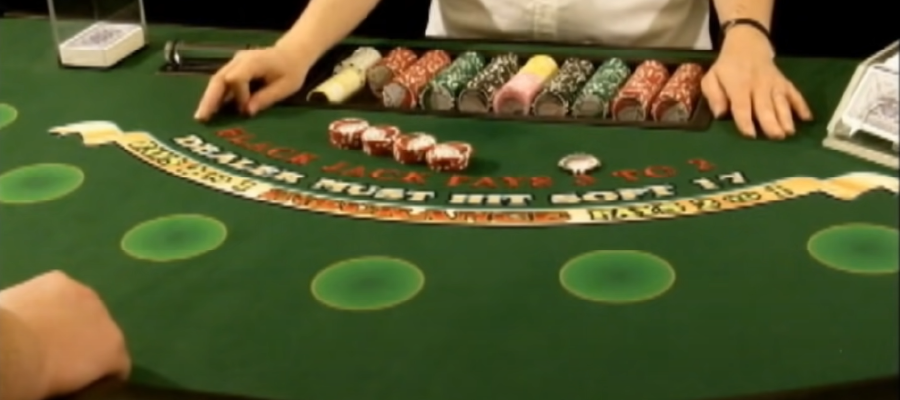
Note the player has given the Dealer a $100 cheque which is placed to the left of the Dealer’s work area.
The Dealer then cuts out $100 in $5 cheques to the left of their work area.
Color Coming In
The Dealer will “Color Up” when a Customer requests to exchange gaming cheques for cheques of a larger denomination.
Get a verbal approval from the Floorperson prior to bringing in cheques for color coming in.
- The Dealer will announce “Color Coming In” in a loud and clear voice.
- After receiving approval from the Floorperson, the Dealer will bring in the Customer’s cheques.
- The Dealer will announce “Coloring Up” and state the amount.
- Color ups of $200 or more must have a verbal acknowledgement from a Floorperson.
- Customer’s cheques will remain on the table until after the changed cheques have been given to the Customer.
- Never place the changed gaming cheques in the betting area.
- Do not turn away from the game when calling out “coloring up”.
Cheque Cutting
The cheques are held in the fingers and placed gently onto the felt.

The index and pinky are at 12 o’clock and 6 o’clock respectively, and the ring and middle finger work together at 3 o’clock and the thumb is at 9 o’clock.
The index and pinky hold the cheques that are to remain in the hand, while the thumb and ring and middle fingers place the cheques being delivered onto the layout.
The pinky acts as a spring in the back of the stack to support the cheques that are to remain in the hand while the thumb, middle and ring fingers place the cheques onto the felt.
Note that the index finger isn’t hooked but is bent away from the cheques.

The index finger slides up the stack to feel how many cheques are to be cut off, and then it and the pinky hold the cheques that are to remain in the hand.
The cheques that are to be placed on the felt are held between the thumb and the ring and middle fingers as they are put down.
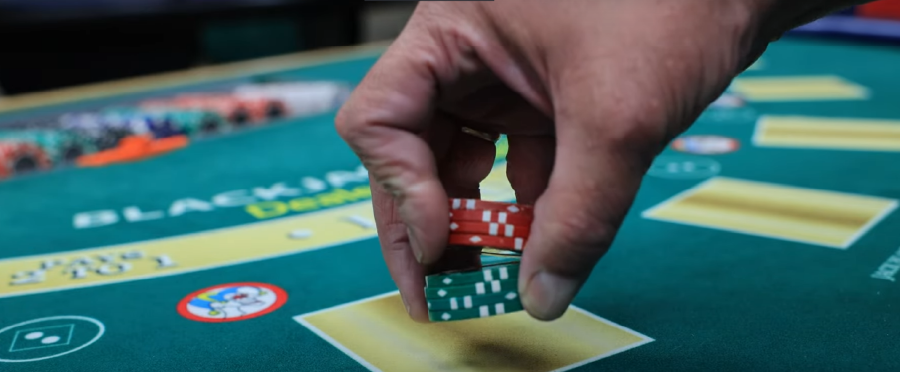
Doing it this way allows the cheques that remain in the hand to be fed down into the thumb and middle/ring fingers. Hooking the index finger will misalign the cheques that remain in the hand, effectively freezing them from being able to move once the green cheques have been placed on the felt.
For demonstration purposes, the thumb, ring and middle fingers have been removed from the cheques to show how the index and pinky hold the cheques that are to remain in the hand.
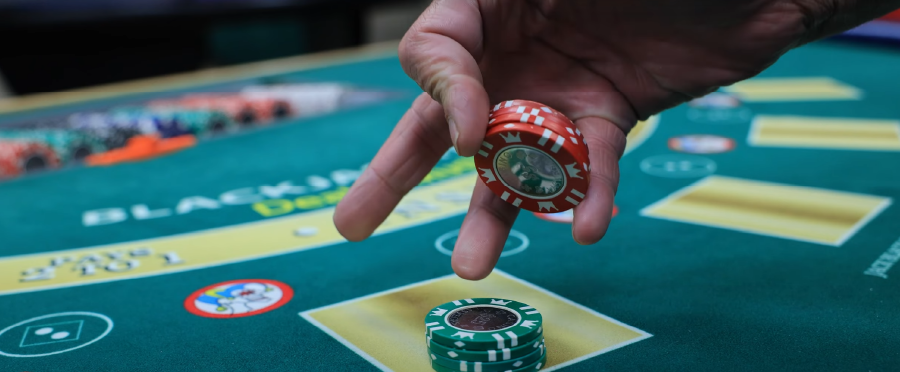
Sizing In
The cheques are held in the same way to size in. The stack in the hand is placed next to the bet to be paid, and the index finger slides across it to select the number of cheques to be left in place.

The pinky still acts as a spring in the back as the cheques are left next to the bet that has been paid.
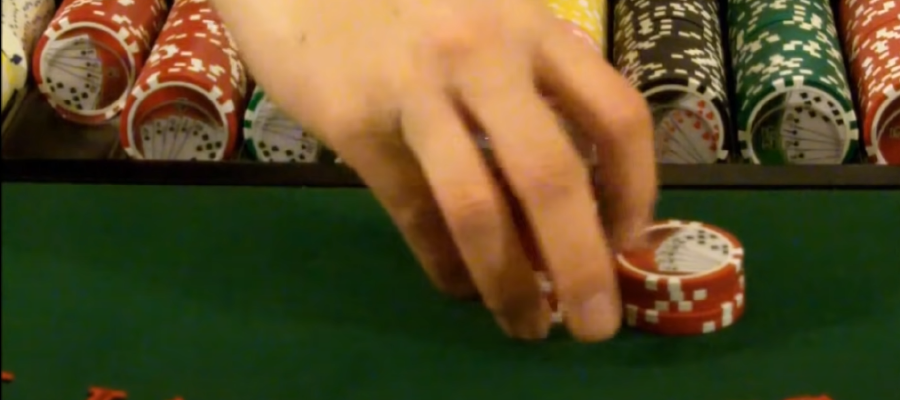
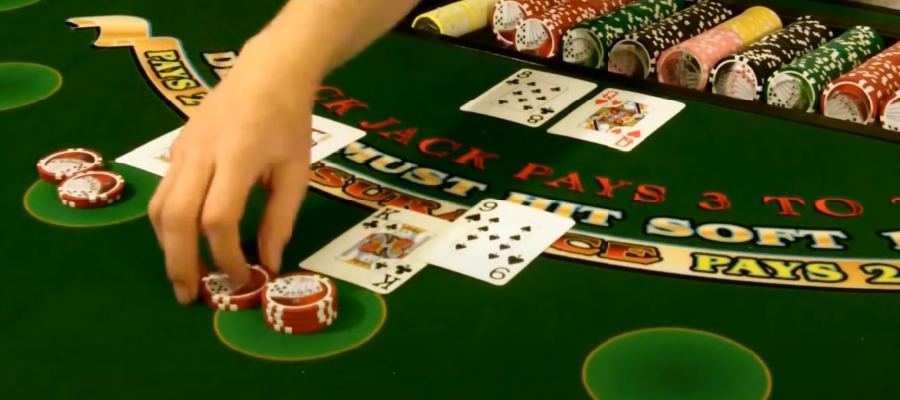
Note the index finger is free to lift off the cheques and reach out to the bet to be paid.
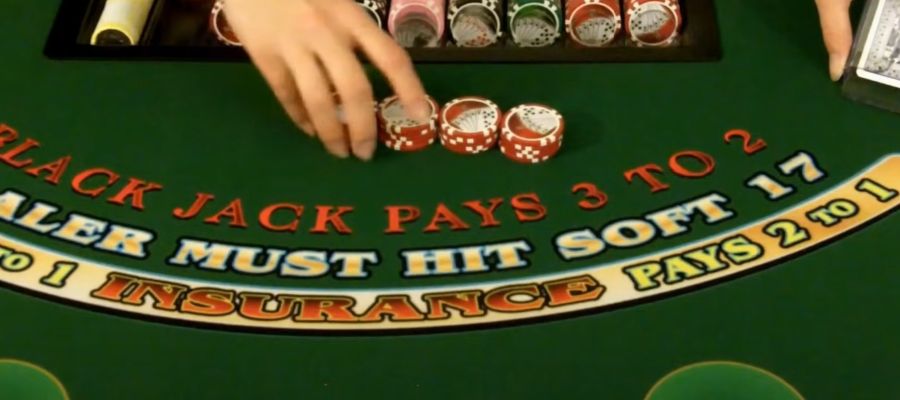
The same motion is used to run down and count a stack of cheques when making change.
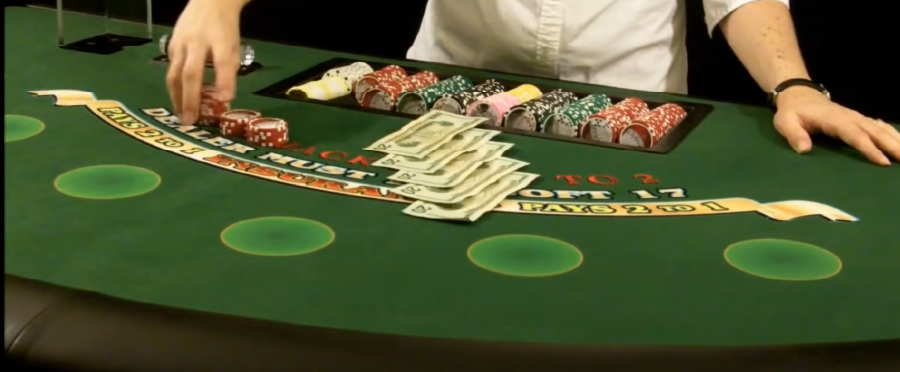
Cheque cutting will be done according to the breakdown below:
Any number of cheques less than 5 are placed in a single short stack. For the $500, $1,000 and $5,000 denomination, break down four cheques into a 2 and 2 formation.
Pro tip
Try to make sure that a player has at least two stacks of their primary betting color before giving them higher denomination chips.
A player who is playing $5 chips who has $50 or so and the Dealer decides to start giving him $25 chips will soon be changing those green chips back to red, slowing the game down while he’s making the change.
Don’t do it!
Clearing the Layout
- At the conclusion of each hand, pick up any cards remaining on the layout in order. Begin with the betting circle to the immediate right of the Dealer and continue counterclockwise.
- Whenever possible, use only one hand when picking up the cards so as not to block the view of the layout for yourself or the Floorperson. Your left hand should remain in contact with the shoe.
- Scoop up each hand so that the third base player’s hand will be nearest to the top of the stack, and the first base player’s hand will be at the bottom of the cards in the Dealer’s hand when the cards are turned over and placed in the discard rack.
Here's an illustrated representation of picking up the cards after the hand is over:
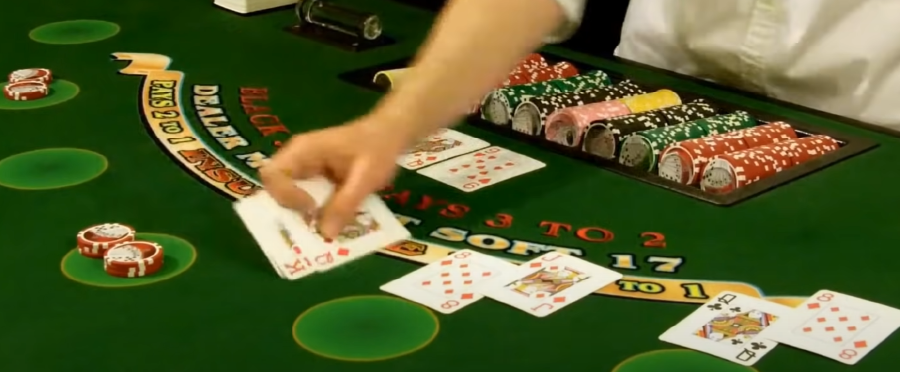
- Pick up the Dealer’s hand last; face-up underneath the Customer’s hands so that the Dealer’s hand is on top of the stack in the discard rack.
The Dealer’s hand is picked up last so the players have the most time to view it, and it will be the first to appear if there is a question about what the Dealer had.
Questions are about the Dealer’s hand more often than any other issue.
- Only a Floorperson or above may take the cards from the discard rack to reconstruct a hand to resolve a dispute.
One thing to be aware of as a Dealer is that the players cannot add up the card totals as quickly as you can.
When a player busts their hand, make sure you pick up the losing bet and place it in the chip tray before you push all the cards together.
It is important that the player be given the time to see that they did have too many before you push the cards together and take the cards away.
Color Coming In
The Dealer will call “Color Coming In” when a Customer requests to exchange gaming cheques for cheques of a larger denomination.
Get a verbal approval from the Floorperson prior to bringing in cheques for ‘Color Coming In’.
- The Dealer will announce “Color Coming In” in a loud and clear voice.
- After receiving approval from the Floorperson, the Dealer will bring in the Customer’s cheques.
- The Dealer will place the Customer’s cheques on the left side of the Dealer’s work area.
- The Dealer announces “Coloring Up” and state the amount.
- The cheques to be sent out to the player will be placed on the right side of the Dealer’s work area.
- Color ups of $200 or more must have a verbal acknowledgement from a Floorperson.
- Customer’s cheques will remain on the table until after the changed cheques have been given to the Customer.
- Never place the changed gaming cheques in the betting area.
- Do not turn away from the game when calling out ‘Color Coming In’.
Dealer being relieved on Handheld Games
When being relieved on a handheld game, the Dealer will:
- Finish the hand in progress.
- Place all the cards in the discard rack.
- Remove all the cards from the discard rack and spread them face down left to right in a short arc across the table, inside the Insurance line.
- The outgoing Dealer will clear their hands and move away from the table to their right.
Clear hands by clapping, showing palms up with spread fingers before leaving the table.
Dealer Being Relieved on Shoe Games
When being relieved on a shoe game, the Dealer will:
- Finish the hand in progress.
- Place the shoe in the center of the table.
- Clear hands by clapping, showing palms up with spread fingers before leaving the table.
- The incoming Dealer will re-position the shoe and continue dealing
Note
We do not burn a card when tapping into a blackjack shoe game.
Conclusion
So that’s a lot of what you need to know to deal blackjack in a casino.
Was it more complicated than you thought?
Yes, there are many little rules to keep you busy. But don’t be discouraged. Once you train enough, it will become as easy as a walk in the park.
Good luck in your dealing journey, whether professionally or for fun with your friends.
Acknowledgements
We would like to thank the following good folks in our business for their help in providing us with some of the photos in this article.
Heather Ferris at Vegas Aces in Las Vegas, Nevada
https://www.vegas-aces.com/
https://www.youtube.com/watch?v=kmM3CjMPuz8
Peter Harrison at the Jack Black Casino Dealers School in Temecula, California
https://www.jackblackonline.com
https://www.youtube.com/watch?v=F6Sx3Bubixc
George Joseph at Worldwide Casino Consulting
http://www.georgejosephtraining.com/

Bonuses
Casinos
Games
Academy
News
Shop
NEW Q&A
Sweepstakes






















































































